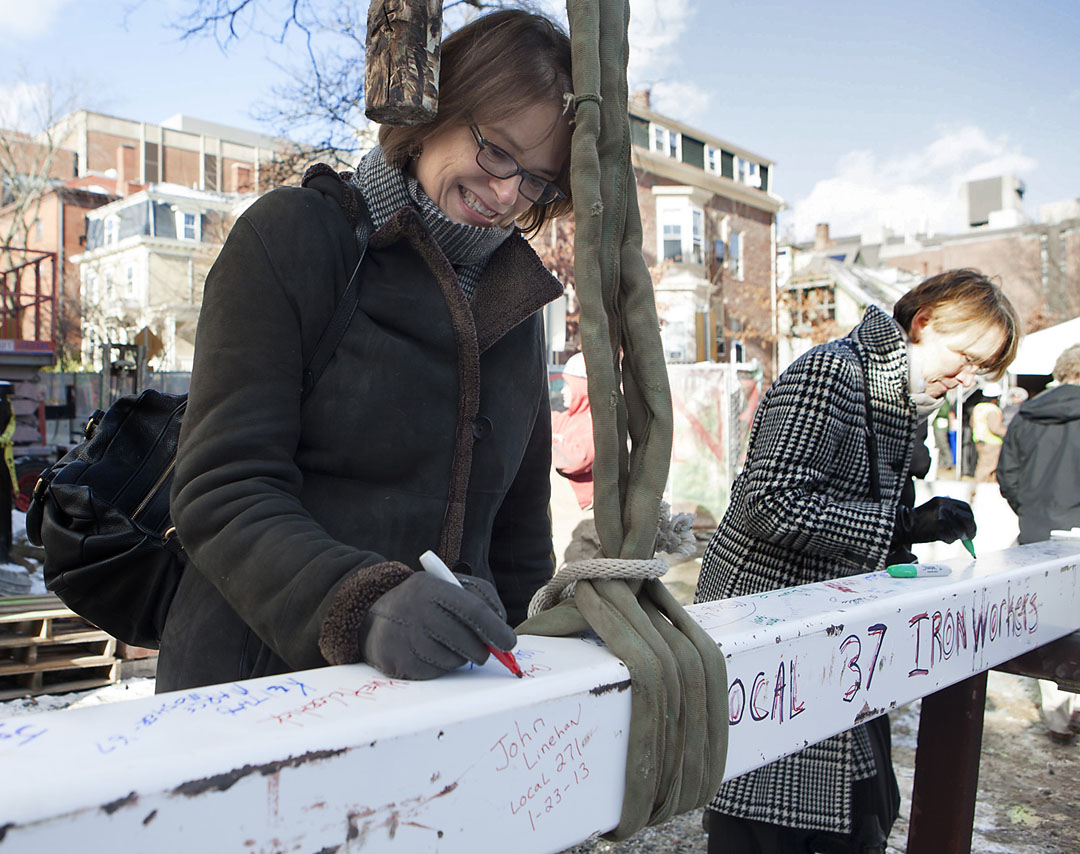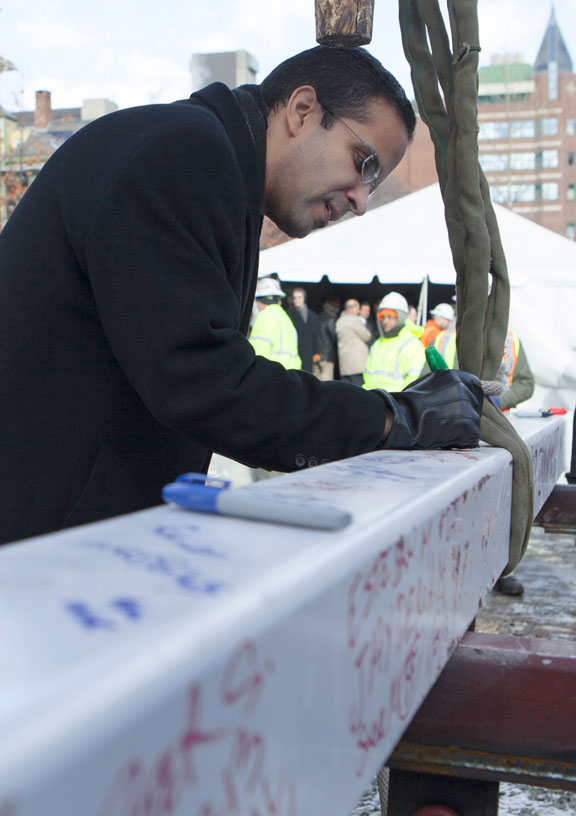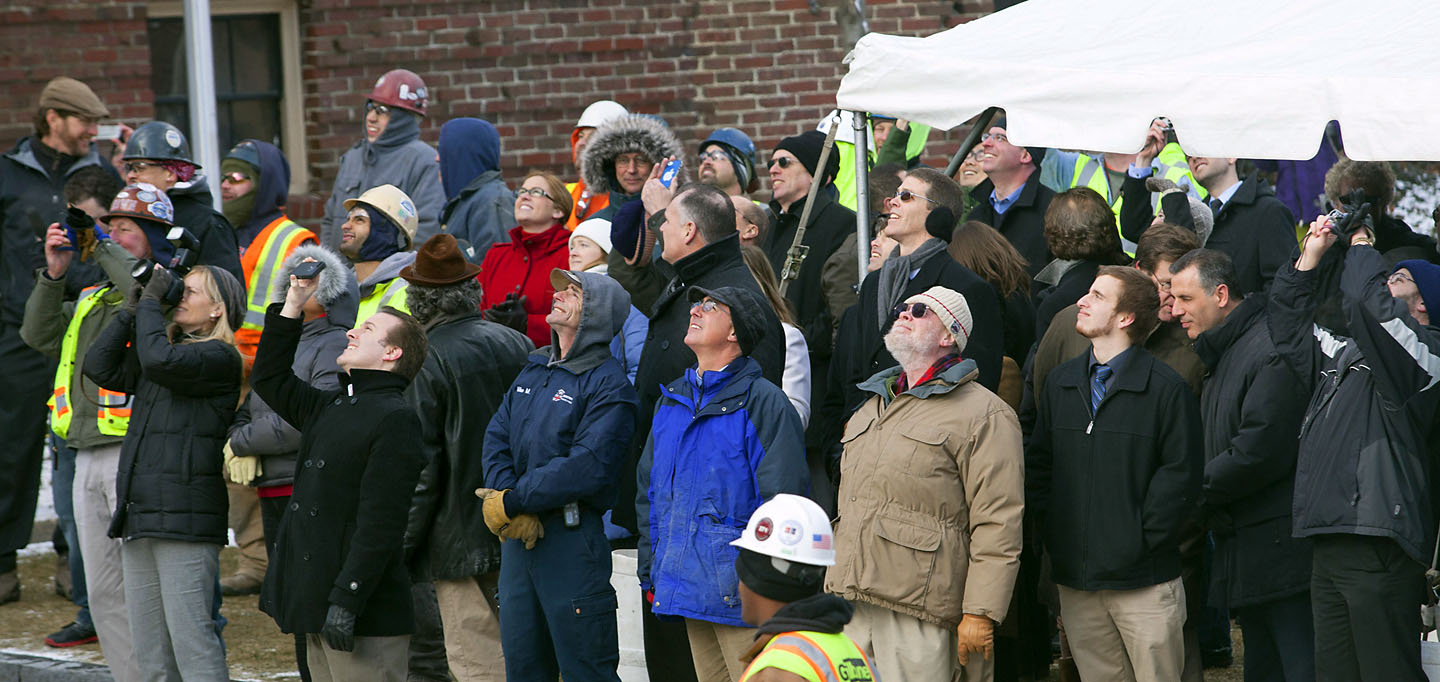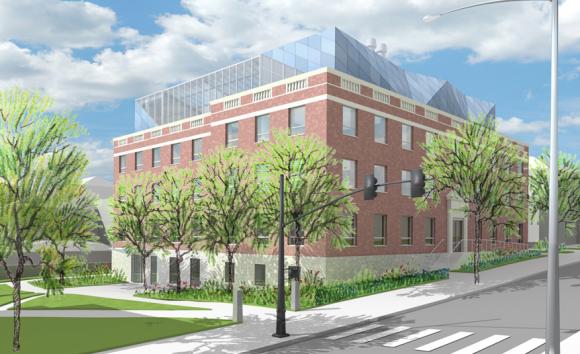PROVIDENCE, R.I. [Brown University] — Brown University representatives and community leaders today celebrated the topping-off of a $35-million renovation project and the signing of a new agreement aimed at providing more opportunities for graduates of Building Futures, an organization that helps to prepare low-income men and women in urban areas for careers in the construction trades.

Workers placed the final beam atop the Building for Environmental Research and Teaching, formerly known as Hunter Lab. When completed in late fall 2013, the building will be a hub for cross-disciplinary teaching, research and engagement in the environmental sciences.
Seven graduates of Building Futures’ pre-apprenticeship program have worked on the project to date, providing demolition, electrical, masonry and other work. The new agreement will expand opportunities for Building Futures graduates to work on projects at Brown.
Under the agreement, Brown adopts the goal that on construction projects over $5 million, at least 15 percent of labor hours will be performed by Building Futures graduates. The agreement was signed by Stephen Maiorisi, vice president of facilities management at Brown; Andrew Cortés, executive director at Building Futures Rhode Island; and Michael Sabitoni, president of the Rhode Island Building & Construction Trades Council.
“We share Building Futures’ commitment to the local economy and hope this agreement will play a role in making sure Building Futures graduates are placed in good jobs after their training is complete,” said Russell Carey, executive vice president for planning and policy at Brown.

“I congratulate Brown University on the construction of this world-class environmental research and teaching facility,” said Providence Mayor Angel Taveras. “Brown is at the forefront of an important national effort to train the next generation of environmental researchers and teachers who can meet the tremendous challenges we face. I also congratulate Brown on its partnership with Building Futures in the construction of this facility, which will provide apprentices the opportunity to acquire skills they need for a solid career in the building trades.”
Founded in 2007, Building Futures has developed a model pre-apprenticeship program that assesses, trains, and supports individuals from underrepresented groups as they transition to family-sustaining careers in the construction trades through a registered apprenticeship training system.
“Brown University continues to be leader among our important institutions, and by adopting this agreement we have taken our partnership to a new level,” said Cortés. “Over 50 Building Futures graduates have advanced in genuine careers through employment on projects at Brown. The apprentice utilization program not only helps our community residents in need but also addresses significant challenges faced by the construction industry.”
Andre Isom is a Building Futures graduate who works for Manafort Brothers, one of the subcontractors on the project. Isom helped with the paving and drainage work on the building.
“This isn’t the first job I’ve worked on at Brown,” Isom said. “There’s work going on here constantly, and if we can get more people from Building Futures to come and work, it only helps the community. I came through a rough time in my life and Building Futures pulled me out of it. It’s a really good program.”
When completed, the renovation project will have provided work for 170 people, and most of the construction materials were purchased in Rhode Island.
A collaborative space for research and teaching
In a construction industry tradition, an evergreen tree was hoisted along with the final beam, which in this case is a herald of things to come for the building. The building’s top level will be the new home to Brown’s Plant Environmental Center, a 4,000 square foot research greenhouse where plant species from all over the world will be grown and studied by Brown students and faculty. The current facility is located beside the building.
The renovated building will include space for 14 faculty members and more than 50 graduate students and postdocs. There will be three classrooms, a 200-seat auditorium, 12 labs, and the greenhouse, which includes a conservatory and space for six additional labs. Administrative offices for Brown’s partnership with the Marine Biological Laboratory at Wood’s Hole and offices for the Environmental Change Initiative, a research initiative linking faculty and students from departments and centers across the Brown campus, will also be housed in the new facility.
“Brown contributes to the economic health of Providence and Rhode Island not only though jobs, but through research activity,” Carey said. “Brown has an exceptional group of faculty from across disciplines who are making great strides in advancing our understanding of how humans are impacting the environment, and this new facility will provide them with a collaborative, state-of-art space in which to pursue new ideas and prepare students to be leaders in environmental research.”
In addition to lab space for individual faculty members, the building will also house Brown’s Environmental And Remote Technologies (EARTH) lab, a facility that combines Geographic Information Systems (GIS) with remote sensing, a science that measures light reflected off the Earth’s surface and allows researchers to study plant, soil, and water characteristics remotely.
Environmental research is by nature cross-disciplinary. Physical and life scientists are interested in how the planet and its ecosystems are changing. Social scientists are interested in how those changes affect the way people live. The renovated building will bring together faculty members from the Departments of Ecology and Evolutionary Biology, Economics, Geological Sciences, and Sociology, and from the School of Engineering.

“What the new building provides is an opportunity for those of us who study the environment to co-locate, to be in the same hallway, to share the same coffee pot if you will,” said Jack Mustard, a professor of geological sciences who will move into the new space. “We’ll have our students mingling with each other and have our labs adjacent to each other. It’s a level of direct interaction that we haven’t had.”
Hunter Laboratory was built in 1958 as a home for Brown’s Department of Psychology. When the department became part of the Department of Cognitive, Linguistic, and Psychological Sciences and moved to the recently renovated Metcalf building, Hunter became available as a space for environmental sciences.
More about the Building for Environmental Research and Teaching
Building features
- Four classrooms, including a 200-seat auditorium
- 12 labs
- 17 conference rooms and informal interaction spaces
- 22 faculty and administrative offices
- 4,000 square-foot research greenhouse with six additional labs
Basic building and project facts
- 51,413 square feet on four levels
- Built by the Gilbane Building Co. (Providence) as a psychology lab in 1958
- Renovation began in August 2012
- Renovation design-build team: Gilbane Building Co. and Toshiko Mori Architect (New York)
- Total cost: $35,307,000
Economic impact
- 170 construction jobs
- 62 tons of steel (fabricated in Massachusetts)
- 288 cubic yards of concrete (purchased in Rhode Island)
- 120,000 linear feet of metal studs (purchased in Rhode Island)
- 3,000 sheets of drywall (purchased in Rhode Island)
- 320 gallons of paint (purchased in Rhode Island)
- 8,380 square feet of new glass
Environmental sustainability
- Over 90 percent of demolition debris (1,100 tons) diverted away from Rhode Island landfill for salvage or recycling
- Rainwater recapture system will supply most of the nonpotable water needs for the building
- High-efficiency lab fume hoods
- High-efficiency heating and cooling with heat recovery will perform over 25 percent better than code
- All new insulated, low-E windows
- Full-envelope insulation
- High-efficiency lighting and daylight controls
- Exterior rain garden to minimize storm water surges and improve runoff water quality
- Shower room for bicycle commuters
- Expected LEED Gold

